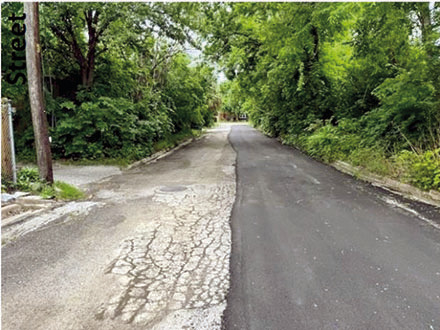A recent survey of Taylor’s streets showed a decrease in the number of failing roads, and City Council recently gave approval for improving more through the Leveling Up program.
“We have 57 percent of our streets in fair, satisfactory or good ranking. That’s a lot better than we had four years ago. We want to continue that trend in minimizing the failed, serious or very poor,” Jacob Walker of HDR Engineering told the council on Thursday.
Walker was discussing the results of a survey conducted by Applied Research Associates. The firm was hired in October to evaluate every city road in Taylor, a total of 301 lane miles.
The survey did not include state or county roads.
The previous study was done in 2019-2020 and only measured the cracks in the pavement. For this go-round, the engineer said they considered not just the pavement condition but also the ride quality of the roads.

“You can have a road that is very cracked but may not be that rough and bumpy, and you may have some roads that are pretty bumpy and tough to drive on, but they actually don’t have that many cracks on them,” he said. “So we asked them to add these two metrics together and put a weighting on each number to come up with an overall condition index.”
The roads were then ranked in seven categories ranging from failed to good. Every street in Taylor has a score, and those scores are useful in knowing what to do with those lanes as far as maintenance or next steps, officials said.
A comparison of 2020 versus 2024 shows a reduction in the amount of failed and serious streets and an increase in satisfactory and good streets, the council was told.
Walker acknowledged this was in part due to the number of new streets being built in the last five years, but did not immediately know how many were constructed.
Earlier this year, the Public Works Department began a program of “leveling up” the city’s worst neighborhood streets. Leveling up is used for streets rated as failed or very poor which are not main arterial roads.
The technique is different from the more commonly known “mill and overlay” because the milling process removes the top level of asphalt before adding new surface. Leveling up simply puts a new surface on top of the old rough asphalt.
The benefits of leveling up are that it can be done by the city without using a contractor, it’s a relatively quick process, and it gives streets an extra one to three years of life, officials said. Public Works Director Jim Gray said the city spent $250,000 on the first phase of the program and has a total budget of $860,000, using funds from transportationutility fees. Phase One topped off about 30 road segments deemed to be in the worst shape. Phase Two will address 39 street segments and cost $236,000. It should be complete by year-end. Phase Three will include about 25 street segments and has a budget of $240,000. That roadwork will begin in spring.
This year, Gray said the department will work on repairing longer segments of the street.
“We were doing a lot of 300-foot segments, and people would get upset because we would get right up to their house and stop. Some of them stopped right in the middle of a block,” Gray said. “This program is not meant as a reconstruction. It’s meant to help the ride and help the look in front of the houses in the program.”
Councilman Gerald Anderson was glad to hear East Second Street would be on the list of roads being fixed in the future, after many years of being overlooked.
Anderson lives on one of Taylor’s four unpaved city streets. Since the previous evaluation method only considered cracks in the pavement, the dirt and gravel roads were graded as having no cracks and therefore not in need of repair.
“Roads like mine weren’t being fixed. They were being missed because they were in such poor condition they were never even being graded,” he said.
At Gray’s suggestion, the council asked staff to schedule a workshop later in the year so they could learn more about budgeting needs for ongoing maintenance and repair of the city’s transportation system.
“
“This program is not meant as a reconstruction. It’s meant to help the ride and help the look in front of the houses.”
— Jim Gray, Taylor Public Works director







